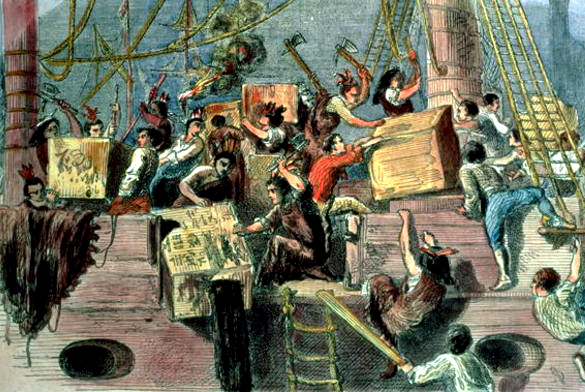Boston Tea Party was a political protest by the Sons of Liberty in Boston, on December 16, 1773. The demonstrators, some disguised as American Indians, destroyed an entire shipment of tea sent by the East India Company, in defiance of the Tea Act of May 10, 1773.
The Boston Tea Party was a key event in the growth of the American Revolution. Parliament responded in 1774 with the Coercive Acts, or Intolerable Acts, which, among other provisions, ended local self-government in Massachusetts and closed Boston’s commerce.
Colonists up and down the Thirteen Colonies in turn responded to the Coercive Acts with additional acts of protest, and by convening the First Continental Congress, which petitioned the British monarch for repeal of the acts and coordinated colonial resistance to them.
As Europeans developed a taste for tea in the 17th century, rival companies were formed to import the product from China. In England, Parliament gave the East India Company a monopoly on the importation of tea in 1698.
When tea became popular in the British colonies, Parliament sought to eliminate foreign competition by passing an act in 1721 that required colonists to import their tea only from Great Britain. The East India Company did not export tea to the colonies; by law, the company was required to sell its tea wholesale at auctions in England.
The Boston Tea Party Museum is located on the Congress Street Bridge in Boston. It features reenactments, a documentary, and a number of interactive exhibits. The museum features two authentically restored ships, the Eleanor and the Beaver. The Beaver, Dartmouth, and Eleanor each carried more than one hundred chests of British East India Company Tea.
The tea came from China and was described as the “Bohea” type. In the 18th century tea trade, black tea was referred to as “Bohea” which traditionally came from the Wuyi Mountain region of China, but the term “Bohea” was hijacked by the tea trade to refer to all black tea varieties.
The first tea ship, Dartmouth, reached Boston November 27, and two more arrived shortly thereafter. Meanwhile, several mass meetings were held to demand that the tea be sent back to England with the duty unpaid.

Tension mounted as Patriot groups led by Samuel Adams tried to persuade the consignees and then the governor to accept this approach. On December 16, a large meeting at the Old South Church was told of Hutchinson’s final refusal.
About midnight, watched by a large crowd, Adams and a small group of Sons of Liberty disguised as Mohawk Indians boarded the ships and jettisoned the tea. To Parliament, the Boston Tea Party confirmed Massachusetts’s role as the core of resistance to legitimate British rule.
A committee was selected to take this message to the Customs House to force release of the ships out of the harbor. The Collector of Customs refused to allow the ships to leave without payment of the duty Stalemate. The committee reported back to the mass meeting and a howl erupted from the meeting hall.
It was now early evening and a group of about 200 men, some disguised as Indians, assembled on a near-by hill. Whopping war chants, the crowd marched two-by-two to the wharf, descended upon the three ships and dumped their offending cargos of tea into the harbor waters.